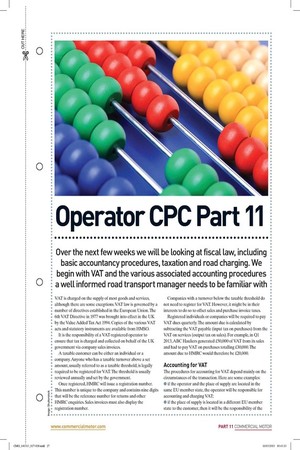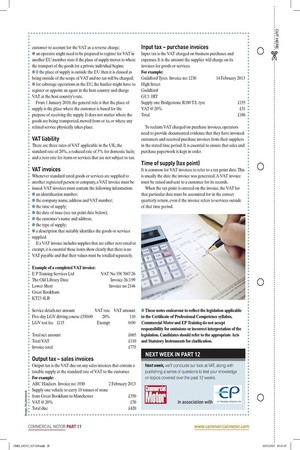Operator CPC Part 11 Over the next few weeks we
Page 15

Page 16

If you've noticed an error in this article please click here to report it so we can fix it.
will be looking at fiscal law, including basic accountancy procedures, taxation and road charging. We begin with VAT and the various associated accounting procedures a well informed road transport manager needs to be familiar with VAT is charged on the supply of most goods and services, although there are some exceptions. VAT law is governed by a number of directives established in the European Union. The 6th VAT Directive in 1977 was brought into effect in the UK by the Value Added Tax Act 1994. Copies of the various VAT acts and statutory instruments are available from HMSO.
It is the responsibility of a VAT-registered operator to ensure that tax is charged and collected on behalf of the UK government via company sales invoices.
A taxable customer can be either an individual or a company. Anyone who has a taxable turnover above a set amount, usually referred to as a taxable threshold, is legally required to be registered for VAT. The threshold is usually reviewed annually and set by the government.
Once registered, HMRC will issue a registration number. This number is unique to the company and contains nine digits that will be the reference number for returns and other HMRC enquiries. Sales invoices must also display the registration number. Companies with a turnover below the taxable threshold do not need to register for VAT. However, it might be in their interests to do so to offset sales and purchase invoice taxes.
Registered individuals or companies will be required to pay VAT dues quarterly. The amount due is calculated by subtracting the VAT payable (input tax on purchases) from the VAT on services (output tax on sales). For example, in 01 2013, ABC Hauliers generated £50,000 of VAT from its sales and had to pay VAT on purchases totalling £30,000. The amount due to HMRC would therefore be £20,000.
Accounting for VAT The procedures for accounting for VAT depend mainly on the circumstances of the transaction. Here are some examples: • if the operator and the place of supply are located in the same EU member state, the operator will be responsible for accounting and charging VAT • if the place of supply is located in a different EU member state to the customer, then it will be the responsibility of the customer to account for the VAT as a reverse charge; • an operator might need to be prepared to register for VAT in another EU member state if the place of supply moves to where the transport of the goods for a private individual begins; • if the place of supply is outside the EU then it is classed as being outside of the scope of VAT and no tax will be charged; • for cabotage operations in the EU, the haulier might have to register or appoint an agent in the host country and charge VAT at the host country's rate.
From 1 January 2010, the general rule is that the place of supply is the place where the customer is based for the purpose of receiving the supply. It does not matter where the goods are being transported, moved from or to, or where any related service physically takes place.
VAT liability There are three rates of VAT applicable in the UK; the standard rate of 20%, a reduced rate of 5% for domestic fuels; and a zero rate for items or services that are not subject to tax.
VAT invoices Whenever standard rated goods or services are supplied to another registered person or company, a VAT invoice must be issued. VAT invoices must contain the following information: • an identification number; • the company name, address and VAT number; • the time of supply; • the date of issue (see tax point date below); • the customer's name and address; • the type of supply; • a description that suitably identifies the goods or services supplied.
If a VAT invoice includes supplies that are either zero rated or exempt, it is essential those items show clearly that there is no VAT payable and that their values must be totalled separately.
Example of a completed VAT invoice: E P Training Services Ltd VAT No 358 7047 26 The Old Library Date Invoice 26.3.99 Lower Shott Invoice no 2146 Great Bookham KT23 4LR Five-day LGV driving course £550.00 20% 110 LGV test fee £115 Exempt 0.00 Total net amount £665 Total VAT £110 Invoice total £775 Output tax sales invoices Output tax is the VAT due on any sales invoices that contain a taxable supply at the standard rate of VAT to the customer. For example: ABC Hauliers Invoice no: 1930 2 February 2013 Supply one vehicle to carry 10 tonnes of stone from Great Bookham to Manchester £350 VAT @ 20`)/0 £70 Total due £420 Input tax purchase invoices Input tax is the VAT charged on business purchases and expenses. It is the amount the supplier will charge on its invoices for goods or services.
For example: Guildford Tyres Invoice no: 1230 14 February 2013 High Street Guildford GUi 1RT Supply one Bridgestone R180 T/L tyre £155 VAT @ 20% £31 Total £186 To reclaim VAT charged on purchase invoices, operators need to provide documented evidence that they have invoiced customers and received purchase invoices from their suppliers in the stated time period. It is essential to ensure that sales and purchase paperwork is kept in order.
Time of supply (tax point) It is common for VAT invoices to refer to a tax point date. This is usually the date the invoice was generated. A VAT invoice must be raised and sent to a customer for its records.
When the tax point is entered on the invoice, the VAT for that particular date must be accounted for in the correct quarterly return, even if the invoice refers to services outside of that time period.
to the Certificate of Professional Competence syllabus. Commercial Motor and EP Training do not accept responsibility for omissions or incorrect interpretation of the legislation. Candidates should refer to the appropriate Acts and Statutory Instruments for clarification.






































